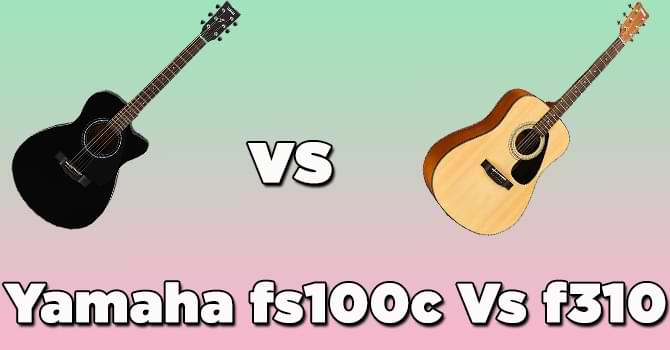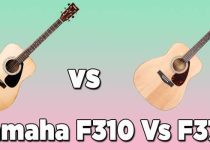Yamaha fs100c Vs f310 [Difference & Which is better]
Unlocking the perfect melody often starts with choosing the right instrument. In the realm of acoustic guitars, two contenders, the Yamaha FS100C vs F310, step into the spotlight. As we embark on a journey to dissect their individual virtues, we’ll traverse the realm of sound, design, and performance, aiding you in discovering which strings will resonate harmoniously with your musical aspirations.

# Table of Contents =>
Comparison Table:
| Features – | Yamaha FS100C | Yamaha F310 |
|---|---|---|
| Body Shape | Concert (Small) | Dreadnought (Larger) |
| Top Wood | Solid Spruce | Spruce |
| Back & Sides Wood | Nato (Eastern Mahogany) | Meranti (Laminated Mahogany) |
| Neck Material | Nato (Eastern Mahogany) | Nato (Eastern Mahogany) |
| Fingerboard | Rosewood | Rosewood |
| Scale Length | 25 inches (634 mm) | 25 inches (634 mm) |
| Nut Width | 1.69 inches (43 mm) | 1.69 inches (43 mm) |
| Bridge | Rosewood | Rosewood |
| Finish | Gloss | Gloss |
| Strings | Steel (Light Gauge) | Steel (Light Gauge) |
| Sound | Bright and Clear | Balanced and Warm |
| Suitable For | Fingerstyle playing, Smaller body preference | Strumming, General acoustic playing |
| Price Range | Mid to High | Budget to Mid |
Overview of Yamaha FS100C –
Part of the renowned Yamaha Folk Guitar series, the Yamaha FS100C stands out with its compact dimensions and effortless playability. Crafted with a spruce top, this guitar produces a harmoniously balanced and articulate sound that caters to both novices and seasoned players. Its smaller body size contributes to a focused tone that’s suitable for fingerstyle playing and intimate performances.
Overview of Yamaha F310 –
The Yamaha F310 belongs to Yamaha’s Standard Series and is renowned for its durability and affordability. Made with a spruce top and meranti back and sides, the F310 produces a robust sound with excellent projection. It’s a versatile guitar that accommodates various playing styles, making it a popular choice for those exploring different genres.
Main Difference Between The Yamaha fs100c Vs f310:
a) Sound & Tone:

The sound and tone of an acoustic guitar are perhaps the most crucial factors for any player. The Yamaha FS100C, with its smaller body, delivers a warm and intimate sound that’s perfect for solo artists and singer-songwriters. The spruce top contributes to a balanced tonal profile, making each note clear and distinct. The FS100C’s compact size also emphasizes midrange frequencies, providing a pleasing tonal character.
Conversely, the Yamaha F310’s larger body allows it to produce a louder and more dynamic sound with a strong low end. The combination of the spruce top and meranti back and sides generates a rich and resonant tone that suits strumming and chord-based playing. The F310 offers a wider tonal spectrum, making it suitable for various musical genres, from folk to rock.
b) Strings:
Both the Yamaha FS100C and F310 come equipped with standard steel strings. These strings offer a bright and crisp tone that’s well-suited for the tonal characteristics of each guitar. While you can personalize the choice of strings, the included strings offer a solid starting point for exploring the instruments’ unique sounds.
c) Design and Neck:

An acoustic guitar’s design includes how it looks and how easy it is to play. The Yamaha FS100C has a slightly smaller body, which makes it comfy to hold and play for a long time. Its smooth design & natural finish give it a simple yet classy look. The neck is made for simple fretting. Which is making it good for beginners & players with small hands.
The Yamaha F310 has a bigger body that might feel a bit bulkier, but it makes a rich sound. Its natural finish and basic rosette design give it a classic and ageless appearance. The neck is created for comfy playing, suitable for different styles and hand sizes.
d) Music Genre Suitability:
The choice between the Yamaha FS100C vs F310 can also be influenced by the genre of music you intend to play. The FS100C’s warm and focused tone makes it particularly well-suited for genres like folk, acoustic pop, and fingerstyle arrangements. Its clarity and note separation are ideal for intricate playing techniques.
The Yamaha F310’s versatility shines when it comes to genres that demand a more robust sound, such as rock, country & strum-heavy folk music. Its ability to handle both delicate finger-picking & powerful strumming makes it a go-to choice for musicians who enjoy experimenting with different styles.
e) Comfort and Playability:
Comfort is a critical consideration, especially if you’re planning on long practice sessions or gigs. The Yamaha FS100C’s compact size and lightweight design make it exceptionally comfortable to play, making it a fantastic companion for songwriting and small-scale performances. The smaller body also reduces the reach required to access the upper frets.
The Yamaha F310’s larger body might be slightly less comfortable for some players during extended play. However, its size contributes to a fuller sound, which might be a worthwhile trade-off for those seeking a louder and more impactful presence on stage.
f) Price Range:
Finally, the price point can play a significant role in your decision-making process. Due to its design, tonal characteristics, and the overall reputation of the Folk Guitar series, the Yamaha FS100C often occupies a slightly higher price range. It’s an investment that pays off in terms of its focused sound and comfortable playability.
The Yamaha F310, on the other hand, falls into a more budget-friendly category while still offering exceptional quality and sound. It’s an excellent entry point for beginners and musicians looking for an affordable yet reliable instrument.
Conclusion:
In the Yamaha FS100C vs F310 comparison, the choice ultimately boils down to your personal preferences and musical aspirations. If you value a warm, focused sound for fingerstyle playing and prioritize comfort, the FS100C might be your ideal companion. If you seek a versatile instrument with a broad tonal spectrum that can handle different genres & playing styles, the F310 is a strong contender.
Consider the genres you’ll be playing, your comfort needs, and your budget to make an informed decision. Both guitars bear the Yamaha’s quality craftsmanship, ensuring that no matter which one you choose, you’ll have a reliable partner for your musical journey.
FAQs –
Q: Which guitar is better for fingerstyle playing?
A: The Yamaha FS100C is better suited for fingerstyle playing due to its smaller Concert body shape and solid spruce top. Which delivers a brighter and clearer tone that complements fingerpicked melodies.
Q: Which guitar is better for strumming and general playing?
A: Due to its larger Dreadnought body shape and balanced tone, the Yamaha F310 is better suited for strumming and general acoustic playing. It’s warm tone provided by its spruce top and laminated mahogany back and sides.
Q: Does the choice of wood affect durability?
A: Both guitars are built with quality materials, but the FS100C’s solid spruce top might be slightly more susceptible to dings or dents compared to the laminated spruce top of the F310. However, proper care will ensure their longevity.
Last Updated on September 10, 2023 by Perry Garner


